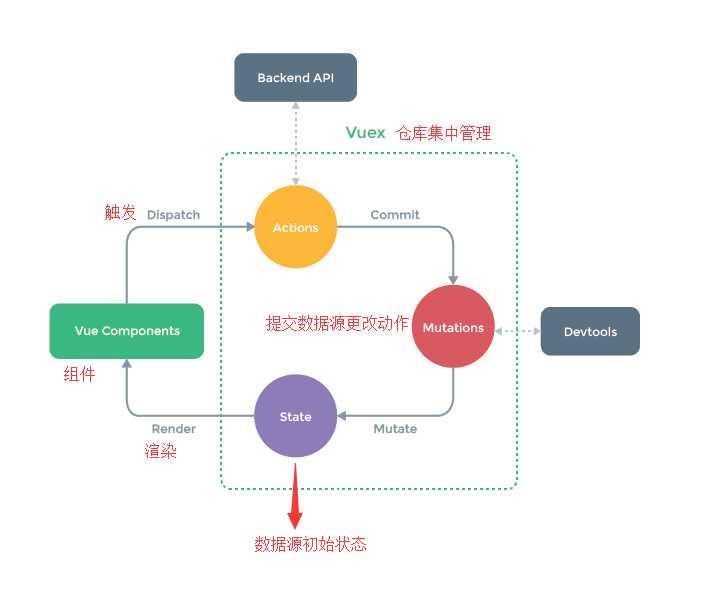这是vuex的语法结构内容
简单的理解vuex:
new Vue({
// state
data () {
return {
count: 0
}
},
// view
template: `
<div>{{ count }}</div>
`,
// actions
methods: {
increment () {
this.count++
}
}
})
state,驱动应用的数据源;(单向数据流)
view,以声明方式将 state 映射到视图;(静态显示出来的数据源)
actions,响应在 view 上的用户输入导致的状态变化 (数据源变化追踪)
---------------------------------------------------------------------------------
vuxe解决了:
1.多个组件共享状态时,单向数据流的简洁性很容易被破坏:
2.多个视图依赖于同一状态。
3.来自不同视图的行为需要变更同一状态。
---------------------------------------------------------------------------------
vuex使用场景:
中大型单页应用,考虑如何更好地在组件外部管理状态,简单应用不建议使用。
---------------------------------------------------------------------------------
Vuex 的状态存储是响应式的
state:
从 store 实例中读取状态最简单的方法就是在计算属性中返回某个状态
如:
view层:
template: `
<div>{{ count }}</div>
`
computed: {
count () {
return store.state.count
}
}
(这种方式频繁操作的话繁琐于是有了更好的解决方式,因为在每个需要使用 state 的组件中都需要频繁地导入)
Vuex 通过 store 选项,提供了一种机制将状态从根组件“注入”到每一个子组件中(需调用 Vue.use(Vuex))
通过在根实例中注册 store 选项,该 store 实例会注入到根组件下的所有子组件中,且子组件能通过 this.$store 访问到
computed: {
count () {
return this.$store.state.count
}
}
(这种方式比较好)
-----------------------------------------------------------------------------------
当一个组件需要获取多个状态时候,将这些状态都声明为计算属性会有些重复和冗余。此时可以用使用 mapState 辅助函数帮助我们生成计算属性(少写好多代码的)
import { mapState } from ‘vuex‘
export default {
computed: mapState({
// ES6箭头函数可使代码更简练
count: state => state.count,
countAlias: ‘count‘, //传字符串参数‘count‘等同于`state => state.count`
countPlusLocalState (state) {
return state.count + this.localCount // 为了能够使用`this`获取局部状态,必须使用常规函数
}
})
}
当映射的计算属性的名称与 state 的子节点名称相同时,我们也可以给 mapState 传一个字符串数组。
computed: mapState([
‘count‘//映射 this.count为store.state.count
])
对象展开运算符(简单的mapState可以传数组和对象对象时候前面的属性是自定义的别名)
computed: {
localComputed () { /* ... */ },
...mapState({ // 使用对象展开运算符将此对象混入到外部对象中
})
}
-----------------------------------------------------------------------------------
同state,vuex里面的getter也是如此:
computed: {
doneTodosCount () {
return this.$store.state.todos.filter(todo => todo.done).length //对数据源进行基本的操作
}
}
(最初始是如果有多个组件需要用到此属性,我们要么复制这个函数,或者抽取到一个共享函数然后在多处导入它)
进而:
Vuex允许我们在store中定义“getter”可以认为是 store 的计算属性)。就像计算属性一样,getter 的返回值会根据它的依赖被缓存起来,且只有当它的依赖值发生了改变才会被重新计算。
mapGetters 辅助函数
mapGetters 辅助函数仅仅是将 store 中的 getter 映射到局部计算属性:
import { mapGetters } from ‘vuex‘
export default {
computed: {
...mapGetters([ //使用对象展开运算符将getter混入computed对象中
‘doneTodosCount‘,(实际就是导出一个方法,可以获取里面的东西和一些操作)
‘anotherGetter‘,
// ...
])
}
}
如果你想将一个getter属性另取一个名字,使用对象形式:
mapGetters({
doneCount: ‘doneTodosCount‘ //映射`this.doneCount`为`store.getters.doneTodosCount`
})
-----------------------------------------------------------------------------------
更改 Vuex 的 store 中的状态的唯一方法是提交 mutation:
Vuex中的mutation非常类似于事件:每个mutation都有一个字符串的 事件类型 (type)和一个 回调函数 (handler)。这个回调函数就是我们实际进行状态更改的地方,并且它会接受 state 作为第一个参数:
const store = new Vuex.Store({
state: {
count: 1
},
mutations: {
increment (state) {
// 变更状态
state.count++
}
}
})
(最初始是这样的,但是注意一定是同步操作,异步是不行的)
你不能直接调用一个 mutation的回调,需要store.commit(‘increment‘)
向store.commit传入额外的参数,叫做mutation的 载荷(payload)
mutations: {
increment (state, n) {
state.count += n
}
}
store.commit(‘increment‘, 10)
在大多数情况下,载荷应该是一个对象,这样可以包含多个字段并且记录的 mutation 会更易读:
mutations: {
increment (state, payload) {
state.count += payload.amount
}
}
store.commit(‘increment‘, {
amount: 10
})
(传进去的是什么,调用的是时候也是传对应的值就好了)
提交的另外一种方式:对象风格的提交方式(此时回调是不变的)
store.commit({
type: ‘increment‘,
amount: 10
})
Vuex 中的 mutation 也需要与使用 Vue 一样遵守一些注意事项:
1.最好提前在你的 store 中初始化好所有所需属性。
2.当需要在对象上添加新属性时,你应该使用 Vue.set(obj, ‘newProp‘, 123), 或者
以新对象替换老对象:state.obj = { ...state.obj, newProp: 123 }
一般会独立开来(使用mutation-types.js存放mutation常量)如:
//mutation-types.js
export const SOME_MUTATION = ‘SOME_MUTATION‘
// store.js
import Vuex from ‘vuex‘
import { SOME_MUTATION } from ‘./mutation-types‘
const store = new Vuex.Store({
state: { ... },
mutations: {
// 我们可以使用 ES2015 风格的计算属性命名功能来使用一个常量作为函数名
[SOME_MUTATION] (state) {
// mutate state
}
}
})
你可以在组件中使用this.$store.commit(‘xxx‘)提交 mutation或者使用 mapMutations 辅助函数(需要在根节点注入 store):
import { mapMutations } from ‘vuex‘
export default {
methods: {
...mapMutations([
‘increment‘, // 将 `this.increment()` 映射为 `this.$store.commit(‘increment‘)`
// `mapMutations` 也支持载荷:
‘incrementBy‘ // 将 `this.incrementBy(amount)` 映射为 `this.$store.commit(‘incrementBy‘, amount)`
]),
...mapMutations({
add: ‘increment‘ // 将 `this.add()` 映射为 `this.$store.commit(‘increment‘)`
})
}
}
-----------------------------------------------------------------------------------
Action 类似于 mutation,不同在于:
1.Action 提交的是 mutation,而不是直接变更状态。
2.Action 可以包含任意异步操作。
简单的:
const store = new Vuex.Store({
state: {
count: 0
},
mutations: {
increment (state) {
state.count++
}
},
actions: {
increment (context) {
context.commit(‘increment‘)
}
}
})
Action 函数接受一个与 store 实例具有相同方法和属性的context(函数上下文)对象,因此你可以调用 context.commit 提交一个 mutation,或者通过 context.state 和 context.getters 来获取 state 和 getters。
context对象并不是store实例本身
提交:
actions: {
increment ({ commit }) {
commit(‘increment‘)
}
}
分发(触发)Action:
store.dispatch(‘increment‘)
异步操作:
actions: {
incrementAsync ({ commit }) {
setTimeout(() => {
commit(‘increment‘)
}, 1000)
}
}
Actions 支持同样的载荷方式和对象方式进行分发:
//以载荷形式分发
store.dispatch(‘incrementAsync‘, {
amount: 10
})
//以对象形式分发
store.dispatch({
type: ‘incrementAsync‘,
amount: 10
})
你在组件中使用 this.$store.dispatch(‘xxx‘) 分发 action,或者使用mapActions辅助函数
import { mapActions } from ‘vuex‘
export default {
methods: {
...mapActions([
‘increment‘, //将`this.increment()` 映射为 `this.$store.dispatch(‘increment‘)`
//`mapActions`也支持载荷:
‘incrementBy‘ //将`this.incrementBy(amount)` 映射为 `this.$store.dispatch(‘incrementBy‘, amount)`
]),
...mapActions({
add: ‘increment‘ //将`this.add()`映射为`this.$store.dispatch(‘increment‘)`
})
}
}
组合action:
实际项目没用过async/await大概理解就是等待执行完上一个方法后(结束后)再走下一步(下一个方法)
// 假设 getData() 和 getOtherData() 返回的是 Promise
actions: {
async actionA ({ commit }) {
commit(‘gotData‘, await getData())
},
async actionB ({ dispatch, commit }) {
await dispatch(‘actionA‘) // 等待 actionA 完成
commit(‘gotOtherData‘, await getOtherData())
}
}
-----------------------------------------------------------------------------------
Module(Vuex 允许我们将 store 分割成模块(module)解决store 对象臃肿)
const moduleA = {
state: { ... },
mutations: { ... },
actions: { ... },
getters: { ... }
}
const moduleB = {
state: { ... },
mutations: { ... },
actions: { ... }
}
const store = new Vuex.Store({
modules: {
a: moduleA,
b: moduleB
}
})
store.state.a // -> moduleA 的状态
store.state.b // -> moduleB 的状态
(简单认为符合上面的组织形式的成为单独模块)(项目不足够大不建议使用)

